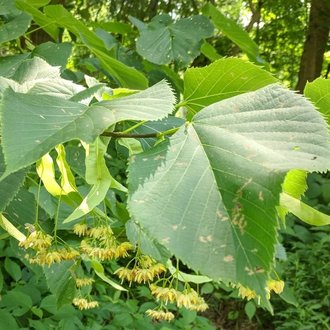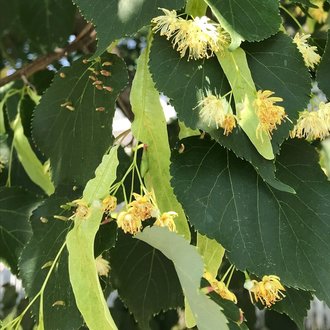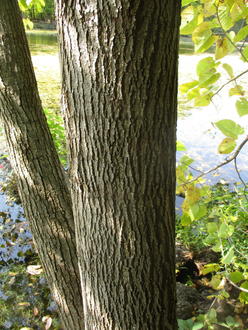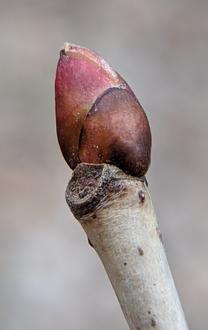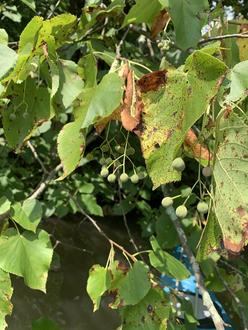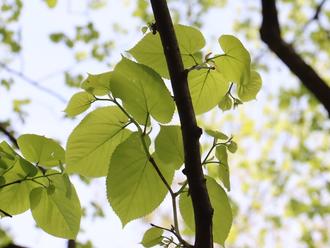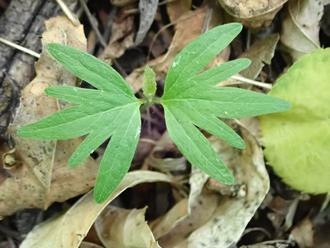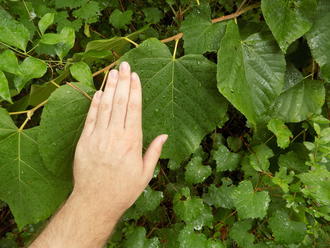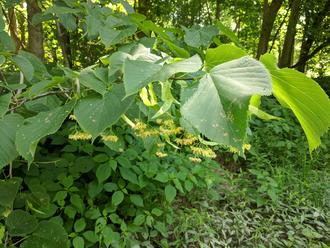American Basswood (Tilia americana L.)
Also known as American linden.
↑Summary
A large deciduous tree native to the eastern and midwestern U.S.
↑Range - Expand
| Legend | Color |
| Native | |
| Native or Introduced or Not Present | |
| Introduced or Not Present | |
| Native or Not Present |
This tentative map is based on our own research. It may have limited data on Canada and/or Mexico, and there is some subjectivity in our assignment of plants as introduced vs. expanded. Read more in this blog post.
Although this plant occurs somewhere in each of these regions, it may only occur in a small part of some or all of them.
↑Description & Identification
A tree to 75-130ft (23-40m) in height, diameter to 36-48in (91-122 cm), growing either with a single trunk or multiple trunks. Bark of mature trees has long, flat-topped vertical ridges, firm in texture, occasionally branching. Bark of mature trees up to 1 inch (2.54 cm) thick at the base of the trunk. Bark of young trees is thinner, smoooth.
Buds are reddish, sometimes with greenish, with only two visible bud scales. Terminal buds are false (directly adjacent to a leaf scar); lateral buds usually strongly asymmetrical.
Root system of mature trees tends to be shallow, especially relative to other associated trees, and consist mainly of lateral roots with no clear taproot.
↑Similar Plants
↑Habitat
Most commonly found on rich uplands and slopes, typically on cooler north and east-facing slopes, but also found in swamps or floodplains. Occurs in many forest types but rarely occurs in pure stands and is only occasionally co-dominant with Sugar Maple (Acer saccharum).
Mostly limited to loamy soils with high nitrogen content. Can grow on sandy loams and silty loams, but grows best on fine-textured soils. Can tolerate soil pH as low as 4.5 but grows best on neutral soils, tolerating up to pH 7.5; more common on calcium-rich soils. In the north of its range, found occasionally on coarse sands, such as sand dunes along Lake Michigan, or dry, sandy ridges in Ontario. However, even in the north of its range, it still has a strong preference for north-facing slopes.
Tolerates some flooding. Competes best against other plants in wet-mesic or dry-mesic conditions; absent from the wettest or driest sites, but on the most mesic sites, outcompeted by other species.
Intolerant of fire and usually only found on sites protected from fire, but fire conditions are less important than soil and moisture in determining the occurrence of this species on a site. Towards the more arid western limit of its range, found only on the eastern shores of lakes and on other locally-moist sites.
Seen as a climax species on some sites, and a subclimax species on others.
↑Life Cycle
Seedlings germinate in shade, and can get established in as little as 25% sunlight. However heavy shade can limit seedling growth. Growth rate (and ability to compete favorably with other vegetation) is heavily dependent on soil nitrogen levels; this species takes advantage of high-nitrogen conditions to grow rapidly.
Seedlings quickly establish a long taproot, followed by the development of lateral roots. First-year seedlings may grow a root system to a depth of about 8 inches and a spread of about 3 inches; in the second year the root system primarily expands horizontally. Stem height growth is markedly slower, usually less than half the depth of the taproot in the first year, although growth accelerates in subsequent years. Over time, the taproot becomes less important, and the tree develops an extensive mass of sloped roots, from which the lateral roots procede.
Trees require at least 15 years, usually longer, before producing seed, but some trees have been recorded flowering as early as 10 years of age. Flowers, which form in early summer, and are accompanied by conspicuous bracts, are insect-pollinated, mainly by bees and flies during the day, and moths at night. The bracts, which are conspicuously paler than the tree's foliage, may serve as a visual signal to pollinators, especially at night.
Seeds mature in fall; good production occurs at 1-3 year intervals. Most fruits contain only one seed but a small minority have two seeds, and rarely fruits contain 3 seeds. Seed size and shape is highly variable from one tree to the next, but usually consistent on the same tree. The relatively heavy seeds tend to fall close to the parent tree, but the attached flower bract may aid somewhat in dispersal, carrying seeds as far as 1-2 tree lengths in windier weather.
Seeds form a short-term seed bank, remaining dormant for up to three years. Germination rate of seeds in any particular year is low. Cold dormancy and an acidic environment both seem to facilitate germination. This species reproductive strategy seems to be to have a steady supply of seedlings that germinate and establish in shade, but in the absence of disturbance, most die. In the instance that a small gap with slightly higher light conditions opens up, one of the already-established seedlings will take advantage of the gap.
The leaves of this species are high in nitrogen, calcium, magnesium, and phosphorus, and contribute these nutrients to the litter on the forest floor. The wood is weak and subject to rot, even on live trees. However, the root system often persists longer than above-ground parts of the tree.
This species relies heavily on vegetative reproduction, mostly from stump sprouts, and takes advantage of disturbance such as windthrow. Sprouts grow quickly, allowing this species to reach the canopy and compete favorably with more shade-tolerate species. Resprouts may flower as soon as 8 years after top-kill. Trees will develop adventitious roots if the lower portion of the stem is covered in soil; this occurs frequently when the tree grows on sand dunes with shifting sand.
Trees usually continue bearing fruit for at least 100 years. The maximum lifespan has been estimated at 200 years.
↑Faunal Associations
Numerous insects eat this species, but none cause serious damage except on otherwise stressed trees. The leaves and twigs are often visibly deformed by gall-forming insects.
The linden borer beetle (Saperda vestita) drills tunnels low down on the trunk, and may damage otherwise weak trees, usually young or old ones. The linden looper moth (Erannis tiliaria) eats the leaves of this and numerous other trees. The basswood leaf miner (Baliosus nervosus) larvae mine the leaves. The spring cankerworm (Paleacrita vernata
), fall cankerworm (Alsophila pometaria), white-marked tussock moth (Orgyia leucostigma), and and forest tent caterpillar moth (Malacosoma disstria) eat the leaves as well. The gypsy moth (Lymantria dispar) was introduced from Europe and eats this and many other species, and prefers this species in New England.
This species is also a preferred browse for white-tailed deer.
The wood, which decays easily, provides abundant cavities for cavity-nesting animals, including wood duck, pileated woodpecker, and numerous smaller birds and small mammals.
↑Uses
Widely planted as a shade tree, where it is valued for its tolerance of a wide range of moisture conditions and its fragrant flowers.
The honey bees produce from the blossoms, usually called Basswood Honey in North America, is highly desirable, having a light color, thin consistency, with an aroma that is often described as floral, citrusy, and minty.
Although little-used nowadays, the inner bark was historically used as a source of bast fiber, and made into rope, mats, fish nets, and woven baskets.
↑Related Plants
Two other native Tilia species have limited ranges in Ontario; Tilia of European origin, including both pure species and hybrids, are widely planted as street trees and landscaping plants, and have become established in the wild in several locations.
↑Links & External Resources
• Basswood | The Wood Database (About This Site)
• American Basswood | Fire Effects Information System (FEIS) (About This Site)
• Tilia americana (American Basswood) | Illinois Wildflowers (About This Site)
• Tilia americana (American Basswood) | USDA PLANTS Database (About This Site)
• Tilia americana | Go Botany (About This Site)
• Tilia americana (American Linden) | Missouri Botanical Garden Plant Finder (About This Site)
• American Basswood | Virginia Tech Dendrology Factsheets (About This Site)
• American Basswood | Silvics of North America (About This Site)
• Tilia americana | Biota of North America Project (BONAP) (About This Site)
• Tilia americana | NatureServe Explorer (About This Site)
• Tilia americana | Flora of North America (About This Site)
• Tilia americana | Missouri Plants (About This Site)
• American Basswood | Maryland Biodiversity Project (About This Site)
• Tilia americana L. (Basswood) | Digital Atlas of the Virginia Flora (About This Site)
• Tilia americana L. var. americana (American Basswood) | Digital Atlas of the Virginia Flora (About This Site)
• Tilia americana L. var. heterophylla (Vent.) Loud. (White Basswood) | Digital Atlas of the Virginia Flora (About This Site)



